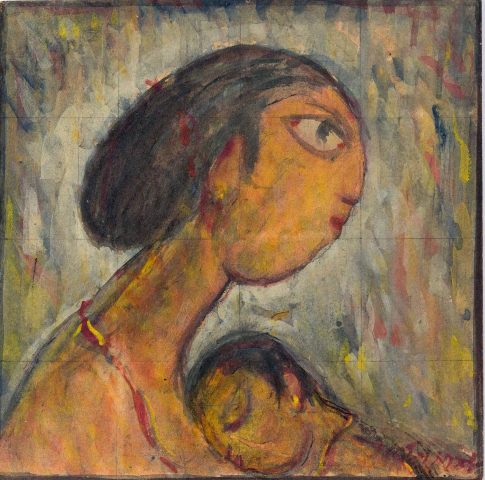Ash’s experiments in art from the 1950s are characterised as avatars; primitive artworks depicting personality traits. His paintings comprise a technique composed of a scientific arrangement of colour dots, almost pointillist. His works are impeccable character studies. Listed below are Ash's avatars up for auction and an attempt to decode the same with reference to their titles.
IRANI (Parsi)
This refers to the Irani / Parsi community predominantly in Mumbai - often depicted with a sharp nose, a classic hat , long chin, and well to do (Jewellery). This 1950 work accentuates the subject’s facial features, hence classifying it as an avatar that is defined as a primitive artwork depicting one’s personality traits.
TRIBHANGA
Tribhanga is a common stance used in traditional Indian Art and popular Indian dance forms such as the Odissi. The word’s literal translation is three parts break. Here, you see the figure bending in one direction at the shoulders and neck, the other direction at the knees, and then the hips.
VILLAGE WOMAN
A character study of a village woman depicting traditional village clothing worn in the rural parts of India.
MOTHER AND SON
This 1948 work studies the close (and simple) relationship between a mother and son.
EXHIBITION HISTORY
Joint Exhibition of the Calcutta Group and the Progressive Artists’ Group, 1950
ROY BAHADUR
During the era of Rani Rashmoni in West Bengal and cultural trappings, Roy Bahadur depicts the stance of the quintessential Zamindar, holding a cane.
TWO SISTERS
Two almost identical baby sisters with simplified and imaginative faces and similar primitive facial features
ORPHAN
This work depicts the wanting eyes of an orphan donning plain, unadorned clothing.
AFTER THE RAID
Could refer to the aftermath of the 1942 Japanese air raids (bombings) in Calcutta, with the mother and child’s eyes emoting a sense of fear.
GYPSY QUEEN
Dabs of vivid colour and elaborate headgear justify the artwork’s title of a Gypsy Queen.
CHILDISH
This portrait with its beady eyes and rounded / curved hands and feet resembles a child in dreamland
DEVI BAHAN (DURGA OR JAGODARTHI BAHON)
Translates to the carrier of Goddess Durga, while the painting shows the magnificent lion Durga is often seen seated on.
IN THE SUN
Fiery colours such as flashes of red and yellow used in the portrait depict similarities to the sun.
FA-HI-AN
This avatar depicts a Chinese Buddhist monk who travelled by foot from China to India to study Buddhist texts
AN IMPRESSION
A colourful portrait that plays on the artistic style of “Impressionism” to create an artwork titled “an impression”
HYPOCRITE
The dark colours surround the avatar with a lower gaze and puckered eye-brows showing a certain amount of pretence
TEMPLE OF SHIVA
A work depicting the quintessential elements of a Shiva temple comprising a towering structure and dome with an Om sign at the top.
MOSGUL
The term Mosgul’s Bengali translation is to be engaged or lost in thought which is depicted by the man’s demeanor.
EXHIBITION HISTORY
Joint Exhibition of the Calcutta Group and the Progressive Artists’ Group, 1950
THE PIPE
The artwork is a simple depiction of a man holding a pipe.
JOY
The work emotes the feeling of joy with the subject’s hands up in the air.
HUNGER
The artwork shows an emaciated dog with a rather scrawny physique signifying hunger.
EXHIBITION HISTORY
Joint Exhibition of the Calcutta Group and the Progressive Artists’ Group, 1950
THE HORSE
Swift strokes of colour depict movement and speed, hence conveying the horse to be in motion.
STARTLED
The painting portrays a deer that seems to have been stopped in its tracks, hence justifying the title.
EXHIBITION HISTORY
Joint Exhibition of the Calcutta Group and the Progressive Artists’ Group, 1950
KATHAKALI
Kathakali is a classical Indian dance form popular in Kerala. The subject seems to be holding a deep bend, not unlike the stance of a Kathakali dancer.
KHOKA BABU (INNOCENT CHILD)
The title translates to an innocent child in Bengali, as depicted in the picture. The subject’s primitive facial features and round eyes convey the same.
BOGGY LAND
A boggy land colloquially refers to a ghost town with two eerie figures representing the same. The dark blue colours further add on to the other worldly atmosphere
COMRADE
This painting represents the relationship between two friends, their camaraderie depicted by holding each other's hands as they walk.
PILGRIM (||)
A pilgrim is a traveller visiting a religious place. The subject’s simple attire comprising a khaki suit is typical of a pilgrim traveller in India.
RUPKATHA
Rupkatha is a Bengali word meaning a folk tale or an imaginative story. The colours themselves seem to be floating around the subject like a dream, with the baby cocooned in the centre.
EXPERIENCE
A gentleman’s face showing signs of wisdom and experience
HILL GIRL
This is a depiction of a girl from the mountains with long eyelashes, a heavily embroidered headdress, and a scarf around her neck.
A DOLL
The painting depicts a wooden doll with squarish facial features and an elaborate costume-like dress
GYPSY MOTHER
A travelling mother clutching her baby tight to her chest, depicting the closeness between a mother and her child.
WATCHMAN
This work depicts a strong and muscular man on the watch, holding a stick in his hand.
AT REST
A woman clad in a sari is seen leaning against a wall, seated on a plush chair, with her hands clasped together portraying a state of rest.
PRAYER
A colourful ornamental figurative in a meditative / prayer-like pose


































